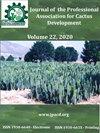两个无花果品种果实和种子的形态和化学特征来自摩洛哥北部的米勒
IF 0.4
4区 农林科学
Q4 HORTICULTURE
Journal of the Professional Association for Cactus Development
Pub Date : 2022-08-18
DOI:10.56890/jpacd.v24i.486
引用次数: 0
摘要
生长在摩洛哥北部得土安省和胡塞马省的两种无花果品种(“Hajria”和“Dellahia”品种)的果实在同一成熟阶段收获。测定了果皮和种子的化学性质(总脂、蛋白质、总糖、水分和干物质),比较了两个品种果实和种子的形态特征(全果重、果肉重、果皮重、受精和流产种子的数量和重量)。表面灭菌后的种子按长度分成6组,分别在Murashige和Skoog基础培养基上萌发。通过分析(1)发芽率与种子长、(2)发芽率与种子重的相关性,确定种子活力。结果表明,省份或品种因素对果实和种子的形态特征有显著影响。果实和果肉质量与种子数量呈正相关。此外,果皮含糖量差异显著(“Dellahia”品种为57.29%,“Hajria”品种为36.66%)。“Dellahia”种子脂肪含量为10.41%,蛋白质含量为8.12%,“Hajria”种子脂肪含量为12.27%,蛋白质含量为8.67%。在两个品种中,从3.5 mm的长度可以保证种子的活力。种子发芽率与长、重的增加呈正相关;然而,这一比率在两个品种之间存在显著差异。本文章由计算机程序翻译,如有差异,请以英文原文为准。
Morphological and chemical characteristics of fruits and seeds of two cultivars of Opuntia ficus-indica (L.) Miller from northern Morocco
Fruits of two cultivars of Opuntia ficus-indica (the “Hajria” and “Dellahia” cultivars) growing in the Tetouan and Al-Hoceima provinces of northern Morocco were harvested at the same ripening stage. The chemical properties (total lipids, proteins, total sugars, moisture, and dry matter) of the peel and seeds were determined and the morphological characteristics (whole fruit weight, pulp weight, peel weight, and the number and weight of fertilized and aborted seeds) of the fruits and their seeds from both cultivars were compared. Surface-sterilized seeds were separated into six groups according to their length and germinated on Murashige and Skoog basal culture medium. Seed viability, by analyzing the correlation between (1) germination rate and seed length, and (2) germination rate and seed weight was determined. Results showed that the province or cultivar factor had significant effects on the morphological characteristics of fruits and seeds. Fruit and pulp weights were positively correlated with the seed number. In addition, a marked difference in the sugar content of the peel was observed (57.29% in the ‘‘Dellahia’’ cultivar compared to 36.66% in the “Hajria” cultivar). The seeds of the “Dellahia” cultivar contained 10.41% fat and 8.12% protein, whereas the seeds of “Hajria” contained 12.27% fat and 8.67% protein. Seed viability was assured from a length of 3.5 mm in both cultivars. The seed germination rate correlated positively with increased length and weight; however, this rate was significantly different between the two cultivars.
求助全文
通过发布文献求助,成功后即可免费获取论文全文。
去求助
来源期刊

Journal of the Professional Association for Cactus Development
Agricultural and Biological Sciences-Plant Science
CiteScore
1.10
自引率
33.30%
发文量
10
期刊介绍:
The editors of the Journal of the Professional Association for Cactus Development, are very excited to be a part of the excellent editorial committee and to work together to create the synergism between scientists, growers, legislators, and business people so vital to the development of this industry to serve the people of arid lands.
 求助内容:
求助内容: 应助结果提醒方式:
应助结果提醒方式:


